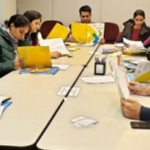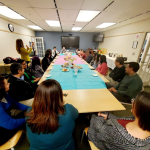12 Foundations for Community Development Practice: Lessons from the Field
Dr. Agnes Thomas
About Dr. Agnes Thomas, Executive Director, CCS, Toronto
Agnes leads the CCS Senior Management Team and joined the organization in 2018. She is a leading community development practitioner and academic with a passion for social justice issues, community building, and organizational transformation. In this role, Agnes is committed to working with a broad scope of stakeholders to build consensus collaboratively, deliver change and drive impact for the 30,000 clients served by CCS’ suite of programs and services.
Agnes served in the not-for-profit sector for more than two decades locally and internationally in various capacities and leadership roles, including at various L’Arche communities around the world, and the Yonge Street Mission and the Jane/Finch Family and Community Centre in Toronto. She is also a Research Associate with the Ontario Institute for Studies in Education (OISE) at the University of Toronto (U of T) and serves on a number of not-for-profit boards in Toronto. She has also appeared frequently as a guest lecturer and conference presenter, and has an extensive body of research and published work.
Her passion for advocating for the rights of marginalized groups led her to complete and receive her Ph.D. in Adult Education and Community Development with an award-winning thesis from OISE (U). She has a Masters of Arts (M.A.) in Critical Disability Studies from York University, a Diploma in Social Development from the Coady International Institute, St. Francis Xavier University, and a Bachelor of Arts (B.A.) from the Mahatma Gandhi University.
Agnes enjoys teaching, training, coaching, mentoring, volunteering, writing, and photography. Agnes and her husband have three children and live in Scarborough.
Source: CCS
Foundations for Community Development Practice: Lessons from the Field
This brief chapter is presented as a narrative piece to help the reader situate themselves in a community with the task of community development or related work for the first time. This chapter will go over a few principles of operation that will make the work and experience a positive one for all. The themes discussed are broad strokes of lessons learned within community work in some of the neighborhoods in Toronto. While these lessons are drawn out of the urban context of Toronto, I believe they can be applied in any context as these practices are rooted in a strength-based, participatory planning, and delivery model. This chapter is not attempting to provide a framework for community development, as there are many. Instead, it seeks to provide practical and applicable suggestions learned from the field.
Video: Foundations of Community Development and Strengths Based Approach
Video created by Dr. Hasan.
Source: YouTube, Source: https://youtu.be/tgw89KImfIg
Communities are diverse, unique, and have different strengths and capacities. In a metropolitan city like Toronto, with a population of more than 6.3 million people (in the Greater Toronto Area), the community serving sector plays a significant role in maintaining the health and well-being of all who reside here. Along with the issues of housing, employment, food security, etc. often discussed, the recent conversations critically examine the issue of equity and inclusion. The interconnected issues of race, class, gender, disabilities, etc., are at the core of these discussions.
- Learn and listen
- Address power relations
- Planning and Actions
Photo: Dr. Agnes Thomas
1. Understanding community begins with a commitment to learn and listen:
In a strength-based community development approach, the individual and their community are the center of planning and decision-making.
A common theme that often surfaced in many conversations in the community is how the voices of the regular community member are not heard and understood. Frustrations were evident at many planning tables how “leaders” and “planners” from outside the community had a plan for the community without involving its members. In some situations, networking tables trying to solve the issues were halted, and funder representatives were yelled at. When examining the root cause of these disruptions, a picture emerged of people feeling excluded and made invisible in the process of plans that were supposed to help them. There is a lot we can learn from this picture and how we can change some of these practices for positive engagement.
The biggest lesson from these interactions is that no work begins at the community level without learning about the community, and the key to learning is to invest in relationships. Communities tend to come together when a common purpose and plan are developed out of their participation. People are more than happy to talk to you and help prioritize issues once the workers are willing to listen. The more time you spend in a community as a funder, builder, social worker, or whatever your role may be as an outsider, you either become part of the solution or another problem they must deal with. The question for us to ask: do you want to build relationships to approach the issue at hand collaboratively and find a solution or do you feel wasted and underappreciated and leave feeling as if you did not contribute to change? Entering a community as a learner can begin in several ways. Some ways are by joining or planning for an event, spending time at the local school or the community center, and most significantly, having small conversations with people at the local stores, coffee shops, etc.
2. Be consistent and deliver what you promise
The advice you might give a person starting a new relationship, in essence, would be the same when starting in a community. Relationships are not born overnight, and it takes time. You should not promise things you cannot deliver, and do not pretend that you came with solutions to challenges and everything will be fine if people agree to work with you. Even if nobody shows up for your carefully planned event or meeting, don’t be discouraged; be consistent and keep showing up on time until people start seeing you as a constant and genuine individual. How long it takes to build good community connections depends on the previous experiences of the community with other outsiders. Being present and committing time to listen individually and in groups lead to impactful outcomes.
3. Behold the dignity of the individual and community as a core value
There are situations in communities where people go through numerous challenges and require the support of others. Treating people with respect and dignity is fundamental to everything that takes place and influences how you are received and viewed in the community. Many people carry burdens of systemic oppression at multiple levels, and we don’t want to add further to this pain. Programs that run with an attitude of, “I am here to help you, you should be grateful” do not survive long, and even if they do, it is simply because community members had no other alternative. It is vital to be aware of undignified experiences that lead to broken trust and unsafe feelings that create unwelcomed attitudes and cause members to challenge your intent. In a community, a safe space also means an inclusive space where people are visible, heard and respected even when there is a difference in opinions and perceptions and when people need your help, support, and services.
4. Address power relations
Paid worker, volunteer, participant, client – these words and titles have different meanings and carry different scales of power. The tendency to downplay the power relations can make situations unnecessarily complicated. Respectfully address power relations and be transparent. The use of language and words make or break a connection. Invest time to learn the politics of language, and ask yourself if you use language and terms that take power and agency away from someone or question their ability. For example, instead of asking “why” something happened, asking “how” something happened changes how the issue is examined and how the response is formulated and understood. Often unequal power relations are created and applied through language and the words used in policies, programs and everyday interactions. Language can become a powerful tool for transformative change if carefully developed and applied.
5. The Individual and the system issue
Sometimes the issues people face seem like individual problems. However, it could be a system issue manifesting as an individual issue. It is crucial to explore the experiences and the root causes of such problems to determine the approach, especially for people experiencing isolation, discrimination, and other forms of alienation in their local community, schools, service locations, workplaces, etc. In other words, paying attention to the everyday experiences of people and the community provides insight into the interconnection between challenges and experiences and it may offer potential solutions to address the same.
6. Community and community work is not monolithic
Communities move, change and evolve all the time. A cookie-cutter approach to problem-solving will not work often, and a successful initiative in one community may not work in another. Approaching our work flexibly and being willing to change as needed is the first step to a positive outcome. Investing time to learn the intricate threads that connect the various pieces of a community is foundational to good connections and makes the work more organic. Communities are multifaceted – with opportunities and challenges, gifts and talents, and most importantly, solutions and recommendations to address issues. Enter the community with curious wonder and be willing to learn and grow along with the community, impacting members individually and collectively.
Summary
Finally, always remember we are the community; we all belong somewhere and come from neighborhood, places where we want to belong and have a voice in. Before arriving at a conclusion, think and listen to the communities and members’ points of view. In summary, be flexible, create room for dialogue, make reflection part of the daily work, and ask questions when you do not understand. Be humble and remain open to feedback.
Questions for discussion and reflection
“How dare you come and tell me how to run a group when I have been leading this group for the past 15 years? What do you know about us and our lives? You all come and tell us what to do all the time?” (excerpt from a conversation at downtown community)
- What do you think happened here and what caused such reaction? How would you respond? Discuss in your class/group.
“How did you come up with these recommendations? You don’t know our community and what we need; you just got here, and who knows for how long” (Resident at the network table in one of the GTA communities)
- What is happening here? Why is the resident reacting the way they are?
- How would you define community? In your view, what are some of the essential elements of a community, and why?
- What is a strength-based approach, and why do you think it is important?
Learn more
KEY TAKEAWAYS AND FEEDBACK
We want to learn your key takeaways and feedback on this chapter.
Your participation is highly appreciated. It will help us to enhance the quality of Community Development Practice and connect with you to offer support. To write your feedback, please click on Your Feedback Matters.
Thank you!




